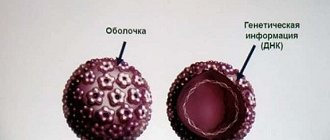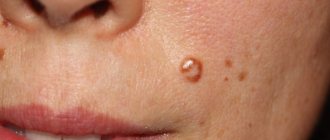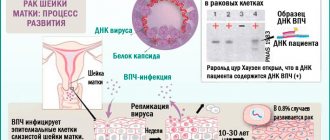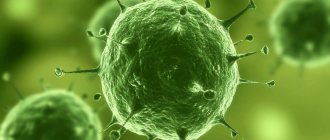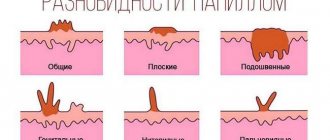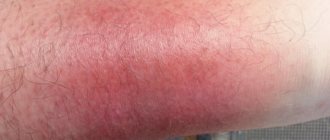Human papillomavirus infection is a chronic disease caused by the human papillomavirus (HPV), which affects the skin and mucous membranes. About 170 varieties of the virus have been described, each of which has a serial number. HPV type 66 in women belongs to a group of high cancer risk: having “settled” in the body, the pathogen increases the risk of developing dysplasia and cervical cancer.
Types of human papillomavirus
Research conducted over the past decades has made it possible to establish that HPV is transmitted only from one person to another, and this can be either a carrier of the infection or a patient with pronounced clinical signs of papillomatosis.
It has been established that papillomavirus is divided into types; there are more than one hundred of them. Depending on the type of virus that has entered the body, all external and internal changes will occur in the future.
Some types of HPV are not at all dangerous to our internal health, and their manifestations on the skin in the form of papillomas and warts are quite successfully eliminated using aesthetic medicine methods. Other subtypes of HPV belong to the group with high oncogenicity, that is, they can affect the formation of malignant tumors in the body.
The division of HPV into types has made it possible to develop treatment tactics for patients with microorganisms detected through testing.
Photos of different types of papillomas
You need to know that infection with one type of papillomavirus does not guarantee that the body is infected from other subtypes. That is, a person can simultaneously be a carrier of several types of HPV, some of them may not pose any danger, while others increase the likelihood of cancer.
The virus is transmitted in several ways, the main one being sexual. Infection is possible when several people use the same towel, razor, or scissors. The pathogen can be transmitted from a woman giving birth to her child; there is also a risk of self-infection, that is, transfer of the virus from one part of the body to another.
The microorganism is so microscopic that it easily penetrates through the slightest cracks in the skin, abrasions and scratches. According to the latest data, up to 90 percent of the entire population of the planet is infected with different types of the virus.
The virus does not always become active immediately. That is, it can remain in the body for a long time in a “sleeping” state, from which a number of provoking factors bring it out.
Transmission routes
Papillomavirus is a highly contagious pathogen that can be transmitted in various ways.
The sexual tract for men and women is recognized as the main one. During intimate contacts, the virus is transmitted from a sick person (carrier) to a healthy person through microscopic defects in the skin or mucous membranes of the epithelium. Even if there are no signs of infection on the partner’s penis, he can infect the woman. The probability of infection during unprotected sex is on average 60%. Unfortunately, the use of barrier contraception (condoms) cannot fully protect against infection, since due to its small size the virus can pass through the pores of a rubber product.
In addition, HPV refers to infections transmitted from a sick mother to a child during childbirth. Detection of clinical manifestations of the disease in a pregnant woman is an indication for cesarean section.
Children and adults can also become infected through close household contacts - when sharing towels, washcloths, and underwear. You can also catch the disease in public places - swimming pool, sauna, bathhouse.
Since the causes of HPV are associated not only with the pathogenicity of the pathogen, but also with the characteristics of human immunity, risk factors for the disease include:
- frequent change of sexual partners;
- ignoring the principles of a healthy lifestyle;
- presence of bad habits;
- unbalanced diet, hypovitaminosis;
- frequent stress;
- failure to comply with personal hygiene rules;
- uncontrolled use of COCs;
- IUD contraception;
- frequent childbirth or abortion;
- periods of hormonal changes in a woman’s body (puberty, pregnancy and lactation);
- early onset of sexually active life;
- concomitant chronic diseases and other infections;
- antibiotic therapy;
- immunodeficiencies, including those caused by HIV.
Oncogenic classification
Oncogenic classification is a division of virus types that takes into account the likelihood of developing cancer depending on the subtype. In total, the division is used in practical medicine into three groups.
First group
A non-oncogenic group, it includes HPV 1,2,3,4,5. If the tests reveal one of these subtypes, then we can assume that you are not at risk of developing cancer from this particular microorganism. But do not forget that infection with other types is possible in the future.
Second
HPV 6,11,42, 43,44 belong to the group with a low probability of developing cancer cells. Under the influence of certain provoking factors, these types of papillomatosis pathogens can lead to cell mutations, which in turn pushes them to develop a malignant tumor.
Third
HPV 16,18,31,33,35,39,45,51,52,56,59,68 is a group of viruses with high oncogenic activity. It has been proven that their presence in a woman’s body greatly increases the risk of a possible cancer process in the cervix and mammary glands. It has been found that in men, oncogenic HPV subtypes can cause bladder cancer.
Naturally, the presence of these stamps does not always indicate that cancer will definitely occur. But if there is the slightest change in well-being or if various growths appear on the mucous membranes and skin, it is necessary to undergo a full examination as soon as possible.
How does infection occur?
The virus is spread only by people who are carriers of the infection.
Routes of infection
Sexual transmission during genital, oral or anal contact by a person.
The risk of infection increases to 60% if sexual intercourse takes place without a condom,
- failure to comply with hygiene rules in public baths and other public places,
- using other people's hygiene products. Children or people with weakened immune systems can become infected this way.
- airborne infection.
There is also the possibility of transmission of the virus to the child from the mother during childbirth. This may damage the baby's larynx, trachea and bronchi. In severe cases, suffocation may occur.
Important to remember! If a person is healthy and has a strong immune system, his body will successfully cope with the danger of complications from HPV 59. Many are carriers of the infection, but only a few suffer from it.
Alcohol, smoking, overwork, lack of sleep, and poor nutrition can lead to decreased immunity. High-risk groups include HIV-infected people, people who have undergone organ transplantation, chemotherapy, and cancer patients.
What is the danger of types 16 and 18?
The risk of developing oncogenic diseases is greatly increased if a person has two types of papillomavirus, 16 and 18.
A study of women with cervical cancer made it possible to accurately establish that in more than half of the cases the direct cause of cell mutation is the type 16 virus.
For a long time after infection, a woman may not realize that she is a carrier of a microorganism dangerous to her health. And only under the influence of certain external and internal influences the virus is activated and begins its work in cells, changing their DNA.
As a result of this, cells begin to rapidly divide and papillomas and genital warts form on the skin, genitals, mucous membranes of the mouth, and inner thighs. Virus type 16 also affects the development in a woman’s body of a precancerous condition such as cervical dysplasia.
Genital warts, caused by virus types 16 and less commonly 18, grow very quickly. Individual elements can merge with each other, and then a large, cauliflower-like growth is formed. The presence of such tumors in the vagina leads to injury and inflammation, which is manifested by corresponding symptoms.
Infection of men with types 16 and 18 of papillomavirus also does not go away without leaving a trace. This microorganism may remain in an inactive state for a long time, but if it develops, men are at risk of infertility and impotence. Virus type 16 also leads to the formation of bowenoid papulosis on the skin of the genitals - spots, erythema, plaques.
Virus strains numbered 16 and 18 can also cause Bowen's disease in men; it is manifested by the formation of a red plaque on the skin of the penis, which over time becomes rough and covered with scales. Bowenoid papulosis and Bowen's disease are considered precancerous changes on the skin.
Virus type 18 is less common than type 16, but at the same time it develops much faster. Treatment consists of using methods to remove external manifestations of the virus - papillomas, condylomas and systemic antiviral treatment. It is also necessary to increase immunity with the help of immunomodulators and vitamin complexes.
After the course, it is imperative to take tests again in order to make sure that the main goal of therapy has been achieved, that is, transferring the virus to an inactive state. If the virus is present, tests must be repeated constantly, this will allow a relapse of the disease to be caught at the very beginning.
HPV 31 and 33
These two types of virus belong to a group with a high degree of oncogenic risk and most often lead to diseases such as bowenoid papulosis and cervical intraepithelial neoplasia .
Bowenoid papulosis is most often detected in men, and the risk of developing this disease is increased with an excessive number of sexual partners. Sometimes self-healing occurs.
Cervical neoplasia can be mild, moderate or severe. In the first case, all changes are revealed only by cytological examination of the smear. Severe neoplasia is considered intraepithelial cancer. Neoplasia in women is often combined with the formation of condylomas, which occur under the influence of viruses types 6 and 11.
Diseases caused by a virus
Warts differ in appearance, structure, and favorite localization zones. The clinical picture is determined by the types of human papillomavirus.
- Viruses types 1 and 2 cause plantar warts. Moreover, type 1 virus provokes the formation of growths with deep roots, which are difficult to treat. Type 2 causes the formation of mosaic-like growths that stick together and are virtually painless. Plantar warts require surgical treatment.
- Virus type 2 also causes warts vulgaris. It is more common in children and adolescents and often goes away without any treatment.
- Viruses types 3 and 5 provoke the appearance of flat growths with a diameter of up to 3 mm, which are more often observed on the face and palms, mainly in young people, which is why they are often called juvenile growths. Warts of this type often go away without treatment.
- Genital warts are caused by viruses types 6 and 11. Neoplasms are located in the genital area, anus, and on the oral mucosa.
- Type 11 virus causes laryngeal papillomatosis, which is transmitted to a child during childbirth from an infected mother, and to an adult through oral sex. In this case, the patient complains of hoarseness and difficulty swallowing. A profuse papillomatous rash may impair breathing.
- Epidermodysplasia verruciformis is provoked by viruses of types 5, 8, 47 (highly oncogenic), as well as 20, 21, 14, 25 (low oncogenic).
- Bowenoid papulosis is caused by viruses types 16, 31-35, 18, 42, 48 and 51-54. These are semicircular flat growths on the mucous membranes and skin.
Among women
Human papillomavirus infection causes the formation of condylomas on the genitals, which is most often observed at the age of 15-30 years. This form can occur hidden.
HPV is the culprit of many gynecological problems.
Genital condylomas, which were not detected in time, develop before menopause and by this time can already cause malignant degeneration of the tissues of the genital mucosa. The most dangerous in this regard are strains 16 and 18.
In men
Male-specific forms of human papillomavirus infection can also occur hidden, but there are exceptions. For example, HPV can lead to diseases such as bowenoid papulosis, in which flat growths with a rough or smooth surface appear on the skin and mucous membranes. The more sexual partners, the higher the risk. If there are signs of the disease, it is worth visiting a urologist, since oncology in men is also possible.
In children
In children, various strains of viruses cause the formation of papillomas on the skin and in the larynx or are present asymptomatically. In the cutaneous form, growths with a diameter of 1-10 mm appear on the hands, fingers, near the nails, in the face, around the knees; this is most often observed at school age. With laryngeal papillomatosis, hoarseness is noted, and rarely, impaired respiratory function (the risk is increased against the background of respiratory diseases). Children's papillomas often go away with age and respond well to treatment.
HPV 51, 52 and 56
Virus strains numbered 51, 52 and 56 also belong to the group with high cancer risk; they are transmitted through sexual contact. These types of virus mainly cause the formation of genital warts.
In women, viruses of types 52 and 56 often lead to cervical dysplasia and erosion. HPV type 52 leads to the formation of genital warts near the anus and inside the rectum. In the future, changes in the structure and division of cells in these places can cause cancer.
HPV type 51 is found in women with cervical carcinoma, vulvar cancer, and in men with cancer of the penis and anus.
Diagnostic methods
There are several ways to detect the presence of HPV in the body; two are currently widely used:
- PCR analysis. This analysis reveals the presence or absence of a virus in the body, its type and the number of viral particles. For diagnosis, a smear taken from women during a gynecological examination and blood are used.
- Daijin test or HPV DNA test. To perform this test, a scraping is taken from the cervical canal. The analysis determines the concentration of the virus in tissues and types HPV, that is, it identifies strains.
If necessary, a biopsy of material taken from removed genital papillomas is prescribed. The data from all examinations are assessed by an oncologist, and only after this a decision is made on choosing the most effective treatment method.
Treatment
Treatment of detected HPV in the body of any person depends on how this virus manifests itself and which group of oncogenic activity it belongs to.
If there are genital warts on the genitals and papillomas on the body, one of the methods for their removal is selected. Cutting off the growths is carried out in the usual surgical way, using a laser, electric current, or under the influence of cold.
If a high concentration of oncogenic viruses is detected in tissues, antiviral treatment is prescribed. Immunomodulatory therapy is required, since only strengthening the defenses will avoid re-exacerbation and prevent the transformation of normal cells into atypical ones.
If precancerous diseases are detected, a course of therapy is selected that corresponds to the manifestations and changes. Cervical cancer, combined with viruses type 16 and 18, is treated with surgery and chemotherapy. Antiviral treatment is optional.
Diagnostic procedures
For timely detection of the disease, women are recommended to undergo regular examination by a gynecologist at least every six months. If any primary signs of the presence of HPV are detected, the doctor must carry out a series of procedures to determine the exact type.
Main research methods:
- Smear. It is taken to conduct a cytological analysis to search for altered cells in a state of cancerous degeneration.
- Colposcopy. Examination of the cervix under a microscope in the presence of visual changes.
- Polymerase chain reaction (PCR). The main method for identifying small concentrations of the virus and its type. The most accurate result is when conducting 2-3 tests.
- Blood test from a vein.
If the disease is detected, both partners must undergo a full examination and it is advisable to abstain from sexual intercourse during this period.
Prevention
It is quite difficult to prevent HPV infection, since some strains can be transmitted when visiting swimming pools, baths, beauty salons and even hospitals. But you can minimize your risk of contracting the types of HPV that are sexually transmitted.
The likelihood of their penetration into the body decreases if you follow these conditions:
- Have one sexual partner. Often, even a condom cannot completely protect against the virus, and therefore it is advisable to be completely sure that your partner does not have HPV.
- After unprotected and protected sexual intercourse with an untested partner, be sure to carefully perform intimate hygiene and use aseptic preparations.
- Begin sexual activity no earlier than 18 years of age. Until this time, girls develop a protective layer of the vagina, and any infection during sexual intercourse quickly penetrates the body.
- Lead a completely healthy lifestyle.
- Treat acute and exacerbation of chronic diseases.
Methods of prevention include periodic visits to a gynecologist for women and a urologist for men. Carrying out examinations will allow timely detection of changes that develop under the influence of HPV.
This video will tell you whether the papilloma virus can cause cancer and who should be vaccinated:
Features and danger of strain 66
Frequent locations of papillomas with HPV 66 are the mucous membranes of the genital organs, less often the external genitalia.
There are 3 types of papilloma virus
- non-hazardous – do not cause degeneration into a malignant neoplasm;
- conditionally dangerous - degenerate into cancer under certain conditions;
- dangerous - lead to the development of dysplasia and cancer.
HPV 66 strain belongs to the second class.
How is hpv 66 transmitted?
- sexual intercourse is the main route of transmission;
- in everyday life - through the patient’s clothes, things and personal hygiene products;
- when visiting public places (swimming pools, baths) - rarely;
- during childbirth - through the birth canal infected with HPV;
- independent infection - movement of the virus from one part of the body to another (through shaving injury).
